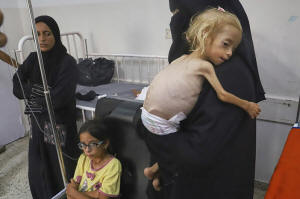Malnourished kids arrive daily at a Gaza hospital as Netanyahu denies
hunger
[August 15, 2025]
By MARIAM DAGGA and LEE KEATH
KHAN YOUNIS, Gaza Strip (AP) — The dead body of 2 1/2-year-old Ro’a
Mashi lay on the table in Gaza’s Nasser Hospital, her arms and rib cage
skeletal, her eyes sunken in her skull. Doctors say she had no
preexisting conditions and wasted away over months as her family
struggled to find food and treatment.
Her family showed The Associated Press a photo of Ro’a's body at the
hospital, and it was confirmed by the doctor who received her remains.
Several days after she died, Israeli Prime Minister Benjamin Netanyahu
on Sunday told local media, “There is no hunger. There was no hunger.
There was a shortage, and there was certainly no policy of starvation.”
In the face of international outcry, Netanyahu has pushed back, saying
reports of starvation are “lies” promoted by Hamas.
However, U.N. spokesman Stephane Dujarric this week warned that
starvation and malnutrition in Gaza are at the highest levels since the
war began.
The U.N. says nearly 12,000 children under 5 were found to have acute
malnutrition in July — including more than 2,500 with severe
malnutrition, the most dangerous level. The World Health Organization
says the numbers are likely an undercount.
The past two weeks, Israel has allowed around triple the amount of food
into Gaza than had been entering since late May. That followed 2 1/2
months when Israel barred all food, medicine and other supplies, saying
it was to pressure Hamas to release hostages taken during its 2023
attack that launched the war. The new influx has brought more food
within reach for some of the population and lowered some prices in
marketplaces, though it remains far more expensive than prewar levels
and unaffordable for many.
While better food access might help much of Gaza’s population, “it won’t
help the children who are severely malnourished,” said Alex DeWaal,
executive director of the World Peace Foundation at Tufts University,
who has worked on famine and humanitarian issues for more than 40 years.

When a person is severely malnourished, vital micronutrients are
depleted and bodily functions deteriorate. Simply feeding the person can
cause harm, known as “refeeding syndrome,” potentially leading to
seizures, coma or death. Instead, micronutrients must first be
replenished with supplements and therapeutic milk in a hospital.
“We’re talking about thousands of kids who need to be in hospital if
they’re going to have a chance of survival,” DeWaal said. “If this
approach of increasing the food supply had been undertaken two months
ago, probably many of those kids would not have gotten into this
situation.”
Any improvement is also threatened by a planned new Israeli offensive
that Netanyahu says will capture Gaza City and the tent camps where most
of the territory’s population is located. That will prompt a huge new
wave of displacement and disrupt food delivery, U.N. and aid officials
warn.
Preexisting conditions
The Gaza Health Ministry says 42 children died of malnutrition-related
causes since July 1, along with 129 adults. It says 106 children have
died of malnutrition during the entire war. The ministry, part of the
Hamas-run government, is staffed by medical professionals and its
figures on casualties are seen by the U.N. and other experts as the most
reliable.
The Israeli military Tuesday pointed to the fact that some children who
died had preexisting conditions, arguing their deaths were “unrelated to
their nutritional status.” It said a review by its experts had concluded
there are “no signs of a widespread malnutrition phenomenon” in Gaza.
At his press briefing Sunday, Netanyahu spoke in front of a screen
reading “Fake Starving Children” over photos of skeletal children with
preexisting conditions. He accused Hamas of starving the remaining
Israeli hostages and repeated claims the militant group is diverting
large amounts of aid, a claim the U.N. denies.

Doctors in Gaza acknowledge that some of those dying or starving have
chronic conditions, including cerebral palsy, rickets or genetic
disorders, some of which make children more vulnerable to malnutrition.
However, those conditions are manageable when food and proper medical
treatments are available, they say.
“The worsening shortages of food led to these cases’ swift
deterioration,” said Dr. Yasser Abu Ghali, head of Nasser’s pediatrics
unit. “Malnutrition was the main factor in their deaths.”
Of 13 emaciated children whose cases the AP has seen since late July,
five had no preexisting conditions — including three who died —
according to doctors.
Abu Ghali spoke next to the body of Jamal al-Najjar, a 5-year-old who
died Tuesday of malnutrition and was born with rickets, which hinders
the ability to metabolize vitamins, weakening bones.
[to top of second column]
|

Islam Qudeih holds her severely malnourished shirtless, 2-year-old
daughter, Shamm, at Nasser Hospital in Khan Younis, southern Gaza
Strip, Saturday, Aug. 9, 2025. Doctors said Shamm may have a genetic
disorder that affects muscle and bone development, but there is no
way to test for it in Gaza. On Tuesday, August 12, her family was
granted permission to travel to a hospital in Italy. (AP Photo/Mariam
Dagga)

In the past months, the boy's weight fell from 16 kilograms to 7 (35
pounds to 15), said his father, Fadi al-Najjar, whose lean face
showed his own hunger.
Asked about Netanyahu’s claim there was no hunger in Gaza, he
pointed at Jamal’s protruding rib cage. “Of course there’s famine,”
he said. “Does a 5-year-old child’s chest normally come to look like
this?”
Skin and bones
Dr. Ahmed al-Farra, Nasser's general director of pediatrics, said
the facility receives 10-20 children with severe malnutrition a day,
and the numbers are rising.
On Sunday, a severely malnourished 2-year-old, Shamm Qudeih, cried
in pain in her hospital bed. Her arms, legs and ribs were skeletal,
her belly inflated.
“She has lost all fat and muscle,” al-Farra said. She weighed 4
kilograms (9 pounds), a third of a 2-year-old’s normal weight.
Doctors suspect Shamm suffers from a rare genetic condition called
glycogen storage disease, which changes how the body uses and stores
glycogen, a form of sugar, and can impact muscle and bone
development. But they can't test for it in Gaza, al-Farra said.
Normally, the condition can be managed through a high-carbohydrate
diet.
Her family applied a year ago for medical evacuation, joining a list
of thousands the WHO says need urgent treatment abroad. For months,
Israel slowed evacuations to a near standstill or halted them for
long stretches. But it appears to be stepping up permissions, with
more than 60 allowed to leave in the first week of August, according
to the U.N.
Permission for Shamm to leave Gaza finally came this week, and on
Wednesday, she was heading to a hospital in Italy.
A child died in her family's tent
Ro’a was one of four dead children who suffered from malnutrition
brought to Nasser over the course of just over two weeks, doctors
say.
Her mother, Fatma Mashi, said she first noticed Ro'a losing weight
last year, but she thought it was because she was teething. When she
took Ro'a to Nasser Hospital in October, the child was severely
malnourished, according to al-Farra, who said Ro’a had no
preexisting conditions.

At the time, in the last months of 2024, Israel had reduced aid
entry to some of the lowest levels of the war.
The family was also displaced multiple times by Israeli military
operations. Each move interrupted Ro’a’s treatment as it took time
to find a clinic to get nutritional supplements, Mashi said. The
family was reduced to one meal a day — often boiled macaroni — but
“whatever she ate, it didn’t change anything in her,” Mashi said.
Two weeks ago, they moved into the tent camps of Muwasi on Gaza’s
southern coast. Ro'a's decline accelerated.
"I could tell it was only a matter of two or three more days,” Mashi
said in the family’s tent Friday, the day after she had died.
Mashi and her husband Amin both looked gaunt, their cheeks and eyes
hollow. Their five surviving children – including a baby born this
year -- are thin, but not nearly as emaciated as Ro’a.
DeWaal said it’s not unusual in famines for one family member to be
far worse than others. “Most often it will be a kid who is 18 months
or 2 years” who is most vulnerable, he said, while older siblings
are “more robust.”
But any number of things can set one child into a spiral of
malnutrition, such as an infection or troubles after weaning.
“A very small thing can push them over.”
___
Keath reported from Cairo. AP journalists Abdel-Karim Hana and Wafaa
Shurafa contributed from Deir al-Balah, Gaza Strip.
All contents © copyright 2025 Associated Press. All rights reserved |